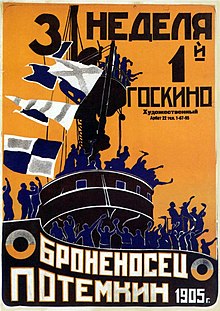Film History/Soviet montage

One of the key ideas of Soviet Montage is the use of editing to create meaning and convey political messages. Soviet filmmakers of the 1920s, such as Sergei Eisenstein, Dziga Vertov, and Vsevolod Pudovkin, believed that the power of film lay in its ability to manipulate the viewer's perception of reality through the use of montage. They believed that by carefully selecting and editing together different shots, they could create a new meaning or provoke a certain emotional response in the viewer.
One of the main principles of Soviet Montage was the concept of "collision," in which seemingly unrelated shots are edited together to create a new meaning. Eisenstein's film "Battleship Potemkin" is one of the most famous examples of this technique. By intercutting shots of the ship's crew, the officers, and the ship's machinery, the film creates a sense of growing tension and inevitability of the revolution. The film used montage to convey the idea of a ship's crew rising up against their oppressive officers, making it a powerful political statement.
Soviet Montage also emphasized the importance of the audience's active participation in the film-viewing experience. Soviet filmmakers believed that audiences were not passive receivers of the film's message, but rather active participants who constructed meaning through the process of watching the film. This idea was in contrast to the dominant Hollywood mode of filmmaking, which emphasized a more linear and narrative-driven storytelling.
The theory of Soviet Montage was influential not just in Soviet cinema, but also in the development of the modern film language and style worldwide. The use of montage and the emphasis on editing as a means of creating meaning and evoking emotion have been adopted by filmmakers from many different countries and backgrounds. For example, the French New Wave and the Italian neorealist movement use montage and other techniques from Soviet montage for their own artistic and political purposes. Additionally, the montage techniques have been adopted by other art forms like music videos and advertising, which also using editing to tell a story or create a specific mood in the viewer.
In summary, Soviet Montage was a film theory and technique developed in the Soviet Union during the 1920s that revolutionized the way films were made and perceived. It emphasized the power of editing to create meaning and convey political messages, and it was influential in the development of modern film language and style.
